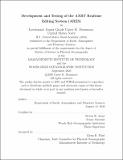Development and testing of the AXBT Realtime Editing System (ARES)
Author(s)
Densmore, Casey R.
Download1227040709-MIT.pdf (8.237Mb)
Other Contributors
Joint Program in Physical Oceanography.
Massachusetts Institute of Technology. Department of Earth, Atmospheric, and Planetary Sciences.
Woods Hole Oceanographic Institution.
Advisor
Steven R. Jayne.
Terms of use
Metadata
Show full item recordAbstract
Airborne eXpendable BathyThermographs (AXBTs) are air-launched, single use temperature-depth probes that telemeter temperature observations as a VHF-modulated frequency. This study describes the AXBT Realtime Editing System (ARES), which was developed to receive and quality control temperature-depth profiles with no external hardware other than a VHF radio receiver. The ARES Data Acquisition System performs fast Fourier transforms on windowed segments of demodulated signal transmitted from the AXBT and uses the resulting spectra to identify valid temperature-depth observations. When evaluated using 389 profiles, the ARES data acquisition system produced temperature-depth profiles nearly identical to those generated using a Sippican MK-21 processor, while reducing the amount of noise from VHF interference included in those profiles. The ARES Profile Editor applies a series of automated checks to identify and correct common profile discrepancies, before displaying the profile on an editing interface that provides simple user controls to make additional corrections. When evaluated against 1,177 tropical Atlantic and Pacific AXBT profiles, the ARES automated quality control system successfully corrected 87% of the profiles without any manual intervention necessary. The ARES Data Acquisition and Profile Editing Systems performed exceptionally well when operationally tested with 44 AXBTs during Hurricane Dorian (2019), enabling high resolution observations across key oceanic features including Dorian's cold wake and the Gulf Stream. Necessary future work includes improvements on the automated quality control algorithm and evaluation against a more diverse dataset of temperature-depth profiles.
Description
Thesis: S.M., Joint Program in Physical Oceanography (Massachusetts Institute of Technology, Department of Earth, Atmospheric, and Planetary Sciences; and the Woods Hole Oceanographic Institution), 2020 Cataloged from student-submitted PDF of thesis. Includes bibliographical references (pages 129-130).
Date issued
2020Department
Joint Program in Physical Oceanography; Massachusetts Institute of Technology. Department of Earth, Atmospheric, and Planetary Sciences; Woods Hole Oceanographic InstitutionPublisher
Massachusetts Institute of Technology
Keywords
Joint Program in Physical Oceanography., Earth, Atmospheric, and Planetary Sciences., Woods Hole Oceanographic Institution.